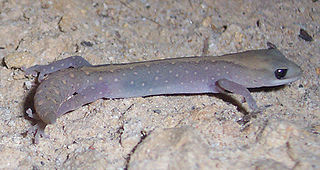
Diplodactylus is a genus of geckos of the family Diplodactylidae from Australia. They are sometimes called stone geckos or fat-tailed geckos. Member species are morphologically similar but genetically distinct.

The Oriental leaf-toed gecko, also known as Bowring's gecko, Sikkimese dark-spotted gecko, or Asian smooth gecko, is a species of gecko endemic to East Asia.
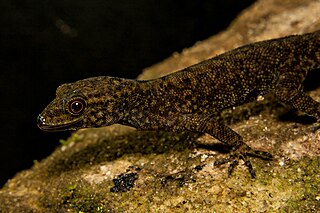
The Wynad day gecko is a species of gecko. It is endemic to the Western Ghats in Kerala, India, and only known from two locations, Wayanad and Silent Valley National Park.
Hemidactylus giganteus, also known as the giant leaf-toed gecko, the giant southern tree gecko, or the giant gecko, is a species of gecko endemic to India.
The south-western spiny-tailed gecko, also known commonly as the soft spiny-tailed gecko, is a species of lizard in the family Diplodactylidae. The species is endemic to Australia. Two subspecies are recognized.

Diplodactylus vittatus, commonly known as the eastern stone gecko, stone gecko, and wood gecko, is a species of diplodactylid lizards that occurs in forest, shrubland and arid regions across Australia. It is widespread across the states of Queensland, Victoria and New South Wales, commonly found in dry peripheral bushlands. This gecko can be kept as a pet or seen within zoo enclosures.
Lucasium steindachneri, commonly called the box-patterned gecko or Steindachner's gecko, is a species of nocturnal, medium-sized lizard in the family Diplodactylidae. The species has a pale strip with three patches of brown along its back. This gecko is terrestrial and only found in arid and semi-arid areas of continental Australia.

The northern spiny-tailed gecko is a species of lizard in the family Diplodactylidae. The species is endemic to Australia.
Lucasium byrnei, commonly known as the gibber gecko or Byrne's gecko, is a species of small, nocturnal gecko, a lizard in the family Diplodactylidae. The species is endemic to Australia.
Lucasium stenodactylum, also known as the crowned gecko or pale-snouted ground gecko, is a species of gecko from Australia.
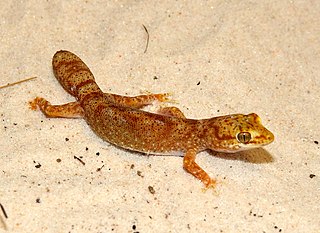
Diplodactylus tessellatus, commonly known as the tessellated gecko, is a small terrestrial lizard found distributed in inland New South Wales, Queensland, Northern Territory, South Australia and the north western corner of Victoria. The tessellated gecko is one of 26 species in the genus Diplodactylus all of which are confined to continental Australia. A small gecko varying in colour from grey to rich reddish-brown with a highly variable dorsal pattern.
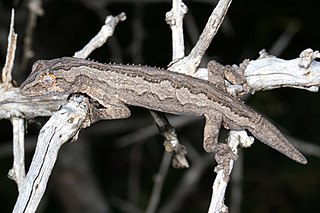
Strophurus intermedius, also known commonly as the eastern spiny-tailed gecko or the southern spiny-tailed gecko, is a species of lizard in the family Diplodactylidae. The species is endemic to semi-arid regions of Australia in New South Wales, Northern Territory, South Australia, Victoria and Western Australia, in mallee shrubland and woodland habitats.
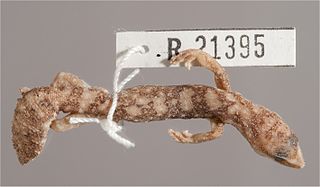
Diplodactylus barraganae, sometimes called the Gulf fat-tailed gecko, is a gecko endemic to Australia.
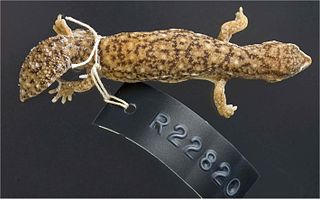
Diplodactylus bilybara, sometimes called the western fat-tailed gecko, is a gecko endemic to Australia. This gecko can be found in Western Australia along the central west coast. The species average length is 6.3 cm or 2.48 inches. These are generally reddish brown or grey. Their reproduction is oviparous.
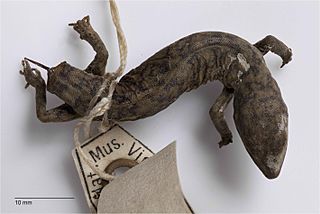
The variable fat-tailed gecko or burrow-plug gecko is a Diplodactylid gecko endemic to central and arid inland areas of Australia. Widespread across the continent, the variable fat-tailed is most commonly found in sandy desert habitats dominated by Spinifex grasses. They have also been bred in captivity by zoos and as pets.
Diplodactylus savagei, known commonly as the yellow-spotted Pilbara gecko, is a species of lizard in the family Diplodactylidae. The species is endemic to Australia.
The short-tailed striped gecko, also known commonly as McMillan's spiny-tailed gecko, is a species of lizard in the family Diplodactylidae. The species is endemic to Australia.

The Exmouth spiny-tailed gecko, also known commonly as Rankin's spiny-tailed gecko, is a species of lizard in the family Diplodactylidae. The species is endemic to Western Australia.
The Western Shield spiny-tailed gecko, also known commonly as Wellington's spiny-tailed gecko, is a species of lizard in the family Diplodactylidae. The species is endemic to Australia.

Strophurus williamsi, also known commonly as the eastern spiny-tailed gecko, the soft-spined gecko, and Williams' spiny-tailed gecko, is a species of lizard in the family Diplodactylidae. The species is endemic to semi-arid regions of eastern Australia including Queensland, New South Wales, Victoria and South Australia. it has become a popular species as a pet for its distinctive tail features. S.williamsi has been grouped within a clade of seven other species that are believed to have diverged from their ancestors around 16 million years ago S.williamsi can be distinguished from closer relatives by arboreality and diurnal (day-active) activity.











